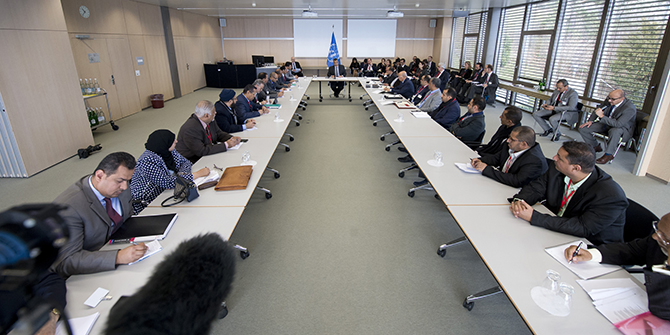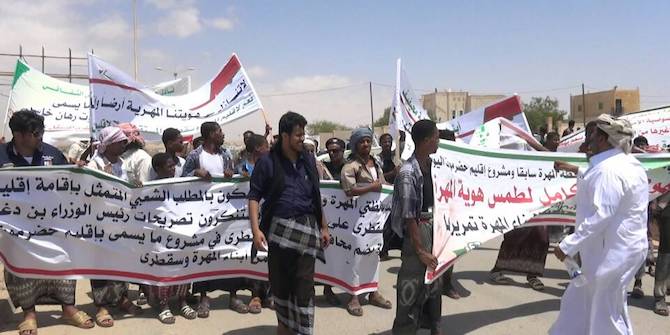by Kate Nevens
#LSEYemen
This memo was presented at a workshop on ‘Yemen’s Urban–Rural Divide and the Ultra-Localisation of the Civil War‘ organised by the LSE Middle East Centre on 29 March 2017.

The governorate of Taiz has been one of the main frontlines of conflict in Yemen over the past two years. Both the city and rural areas within the governorate have experienced exceptionally high levels of violence, including intense ground-fighting between the Houthi–Saleh militias and local resistance forces, airstrikes, indiscriminate shelling in civilian areas, and targeted sniper attacks on citizens seeking medical care, safety and food.
It is estimated that 2.3 million people – almost 80 percent of Taiz’s total population – are in need of humanitarian assistance. A Houthi blockade on goods entering the city has put a stranglehold on the highly populated urban areas, and the price of essentials, including food and water, have rocketed, leaving much of the population malnourished. With very little medicine coming through, and hospitals being attacked, the healthcare system is on the verge of collapse.
Unsurprisingly, Taiz has also seen extremely high levels of displacement. In a reversal of the previous trend of young people moving to the city from rural areas for work, many people are fleeing their homes in the city to seek respite in their ancestral villages. However, many rural areas are also affected by the conflict, and large numbers of people are fleeing to neighbouring governorates of Hodeidah and Ibb. In February 2017 alone, over 50,000 Taizis are thought to have been displaced in the latest rounds of fighting.
Underlying Security and Safety Issues in Taiz
For the past five years the conflict prevention organisation Saferworld has been working with two local communities in Taiz – in the old city of Al Mudhaffar, and in a rural location in Taizziyah district. Referred to locally as the ‘Communities Build Peace’ project, communities formed local action groups to identify and tackle a variety of safety issues affecting their daily lives.
Some of the main community concerns prior to the conflict, common to both the city and rural location, included lack of basic services; economic insecurity and falling levels of education and employment; and lack of relationship with formal security providers, notably the police. The old city, an area of narrow, densely populated streets, had particular problems with badly managed garbage, poor sewerage and water systems, stray dogs and inadequate street lighting. Local government services to deal with these problems existed, but were weak, ineffectual and ill-resourced. In the rural area, the local government had little to no reach at all, and the majority of issues, such trucking in water and local conflict over land, were dealt with by the local Sheikh.
In both locations, lack of economic opportunities was a big concern for almost all individuals and families, with additional problems associated with youth unemployment and child labour. There were reports of young men being paid to join local militias (including payment in drugs) and increasing numbers of children dropping out of school, particularly girls in Taizziyah. Issues around street harassment, domestic violence and sexual exploitation of women and children were also frequently mentioned as local safety concerns.
Both communities were highly reliant on informal authorities to assist with local safety issues. Prior to the conflict, there was a functioning police service in the old city, but trust in the police was low. This was in part because of the prevalence of bribery and corruption, but also due to the length of time it can take for a response, and the inadequate responses received. Local mayors (ʿaql) and other notable male leaders often worked as middle men between the communities and the police. Unlike the old city, the village in Taizziyah did not have any formal police presence, and it was reported that the nominal police station did not have enough resources (cars or petrol) to even travel to the village. The police reported that they themselves felt unsafe, long abandoned by the central state and receiving only half their salaries.
Looking at some of these underlying issues, it is not difficult to see that the advent of conflict could quickly create a state of severe crisis. The already huge gaps in basic service provision have become cavernous. The existing issues around garbage collection and sewers in the old city, for example, have multiplied and have led to fatal levels of disease outbreaks.
Similarly, in the last two years private companies and factories in Taiz have been forced to close, while government employees have not received salaries since August 2016, driving the already faltering economy of Taiz further into the ground. An assessment by Save the Children in Taiz shows that over 30% of Taiz citizens have lost work opportunities, and almost 10% of households reporting sending their children to look for work. Taizis are joining the resistance effort as a source of income; some youth are paying their university fees by being part-time fighters. The number of child marriages appears to be rising, and emerging reports suggest that women, particularly those in IDP camps, are being sexually exploited for income.
Rule of law has all but collapsed, leaving Taiz as a patchwork of power bases, with different groups controlling different areas and even more subject to the whims of local personalities.

A Community Response to Conflict
Unfortunately, almost all of the local community action group in Taizziyah have been displaced by the war. However, Saferworld’s community groups in the old city of Al Mudhaffar are actually more active since the conflict began, managing to sustain the community relationships they’d built pre-conflict.
Like communities across Yemen, active citizens are filling in the vacuum left by the collapse in state service provision and the almost complete withdrawal of international funding. In Muthafar, men and women from the action group have been involved in water delivery, food distribution, street cleaning, civil safety training, providing classes for children that are missing school and even installing street lights so that people could feel more comfortable moving around freely and safely. Community groups are also leading the way in promoting social cohesion through videos, street art, songs, festivals, theatre and exhibitions.
Obviously the challenges around this type of work are enormous, fraught with safety issues, particularly in an environment where the space for civil society activity is narrowing. In Taiz, the Houthi–Saleh forces have been raiding homes and local NGO offices, and arbitrarily arresting and detaining people they believe to be part of the political opposition. Local resistance forces – including fighters from elsewhere in Yemen – are divided and fighting amongst themselves, trying to gain control of supply routes. Taiz citizens, fighting to survive, often report that they do not know who is shooting at them.
Interestingly, relationships in Al Mudhaffar between citizens and informal and formal authorities at a very local level have also not completely vanished. While some of the key relationships at a governorate level have disappeared, members of the local council and the local ʿaql and even resident police officers continue to play a positive role in the community, as individuals as much as representatives of their institutions.
Although trust in authorities has been low for some years, civilians in Taiz still overwhelmingly want to see an end to the presence of armed groups and the return of some form of formal order, with professional police forces and elected councils that can work to restore basic services. The role of local governance – and its relationship to local citizens – remains essential to any future peacebuilding process, and the groundwork for this is being laid now by community activists across Yemen.
Kate Nevens is the former Head of the Middle East and North Africa Programme at Saferworld. She currently lives in Edinburgh, working on gender equality issues and campaigning against the arms trade. She tweets at @katenevens.
Other Contributions in the Series
- Yemen’s Rural Population: Ignored in an Already-Forgotten War, Helen Lackner
- Empire of Information: The War on Yemen and its Agricultural Sector, Martha Mundy
- The Battle to Control the ‘Commanding Heights’ of the Yemeni Economy, Rafat Al-Akhali
- Saada: Ground Zero, Gabriele vom Bruck
- From Protesters to Politicians: The Rise of the Houthis, Nawal Al-Maghafi
- Taiz Youth: Between Conflict and Political Participation, Maged Sultan
- Healthcare under Siege in Taiz, Sophie Désoulières
- Aden: Relief Challenges and Opportunities, Awssan Kamal
- Marib: Local Changes and the Impact on the Future of Yemeni Politics, Alkhatab Al-Rawhani
- Hadhramout from Federalism to Civil War: Demands and Realities, Baraa Shiban






